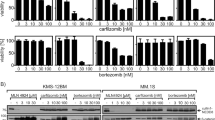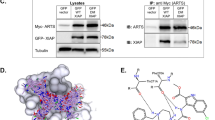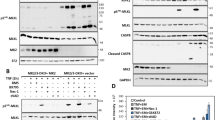Abstract
The tumor necrosis factor receptor (TNFR)-associated factor (TRAF) family of six adaptor proteins (TRAF1–6) links the TNFR superfamily to the nuclear factor kappa B (NF-κB) and activator protein-1 (AP-1) transcriptional activators. Unlike other TRAFs, TRAF6 is also involved in Toll-like/interleukin (IL)-1 receptor (TIR) signal transduction. Thus, inhibition of TRAF6 function could interrupt both CD40 (TNFR family) and IL-1 growth signals, pathways critical to myeloma proliferation. To block TRAF6-mediated IL-1 signaling, we constructed small interfering RNA (siRNA) against TRAF6. We found that siRNA targeting the TRAF6 C-terminal (siTRAF6C) receptor interaction domain specifically reduced only TRAF6 protein expression, without affecting TRAF2 or 5 levels, and substantially interfered with IL-1-induced NF-κB and c-Jun/AP-1 activation. Inhibition by siTRAF6C was concentration-dependent. SiTRAF6C also significantly reduced myeloma proliferation and enhanced apoptosis in a similar dose-dependent fashion in vitro. More importantly, marked siTRAF6C growth inhibition was detected in vivo when these cells were implanted into the bone marrow of irradiated normal mice. In contrast, introduction of siRNA derived from the TRAF6 Zn-finger domain or an irrelevant siRNA construct failed to alter cell growth or cell death. These studies suggest that TRAF6 may be a new molecular target to block cell signal transduction important for the survival and proliferation of multiple myeloma cells.
This is a preview of subscription content, access via your institution
Access options
Subscribe to this journal
Receive 50 print issues and online access
$259.00 per year
only $5.18 per issue
Buy this article
- Purchase on Springer Link
- Instant access to full article PDF
Prices may be subject to local taxes which are calculated during checkout






Similar content being viewed by others
References
Aderem A, Ulevitch RJ . (2000). Nature 406: 782–787.
Armstrong AP, Tometsko ME, Glaccum M, Sutherland CL, Cosman D, Dougall WC . (2002). J Biol Chem 277: 44347–44356.
Berenson JR, Crowley JJ, Grogan TM, Zangmeister J, Briggs AD, Mills GM et al. (2002). Blood 99: 3163–3168.
Berenson JR, Ma HM, Vescio R . (2001). Semin Oncol 28: 626–633.
Bharti AC, Takada Y, Shishodia S, Aggarwal BB . (2004). J Biol Chem 279: 6065–6076.
Callander NS, Roodman GD . (2001). Semin Hematol 38: 276–285.
Cao Z, Tanaka M, Regnier C, Rothe M, Yamit-hezi A, Woronicz JD et al. (1999). Cold Spring Harb Symp Quant Biol 64: 473–483.
Cao Z, Xiong J, Takeuchi M, Kurama T, Goeddel DV . (1996). Nature 383: 443–446.
Chatterjee M, Stuhmer T, Herrmann P, Bommert K, Dorken B, Bargou RC . (2004). Blood 104: 3712–3721.
Cheng G, Cleary AM, Ye ZS, Hong DI, Lederman S, Baltimore D . (1995). Science 267: 1494–1498.
Chung JY, Park YC, Ye H, Wu H . (2002). J Cell Sci 115: 679–688.
Corso A, Ferretti E, Lunghi M, Zappasodi P, Mangiacavalli S, De Amici M et al. (2005). Cancer 104: 118–125.
Eferl R, Wagner EF . (2003). Nat Rev Cancer 3: 859–868.
Feng X . (2005). IUBMB Life 57: 389–395.
Inoue J, Ishida T, Tsukamoto N, Kobayashi N, Naito A, Azuma S et al. (2000). Exp Cell Res 254: 14–24.
Kobayashi N, Kadono Y, Naito A, Matsumoto K, Yamamoto T, Tanaka S et al. (2001). EMBO J 20: 1271–1280.
Lomaga MA, Yeh WC, Sarosi I, Duncan GS, Furlonger C, Ho A et al. (1999). Genes Dev 13: 1015–1024.
Ma MH, Yang HH, Parker K, Manyak S, Friedman JM, Altamirano C et al. (2003). Clin Cancer Res 9: 1136–1144.
Naito A, Azuma S, Tanaka S, Miyazaki T, Takaki S, Takatsu K et al. (1999). Genes Cells 4: 353–362.
Nakanishi C, Toi M . (2005). Nat Rev Cancer 5: 297–309.
Pagnucco G, Cardinale G, Gervasi F . (2004). Ann NY Acad Sci 1028: 390–399.
Sanda T, Iida S, Ogura H, Asamitsu K, Murata T, Bacon KB et al. (2005). Clin Cancer Res 11: 1974–1982.
Sinha SK, Zachariah S, Quinones HI, Shindo M, Chaudhary PM . (2002). J Biol Chem 277: 44953–44961.
Tai YT, Li X, Tong X, Santos D, Otsuki T, Catley L et al. (2005). Cancer Res 65: 5898–5906.
Takeuchi M, Rothe M, Goeddel DV . (1996). J Biol Chem 271: 19935–19942.
Teoh G, Tai YT, Urashima M, Shirahama S, Matsuzaki M, Chauhan D et al. (2000). Blood 95: 1039–1046.
Vincent T, Mechti N . (2005). Leukemia Lymphoma 46: 803–811.
Yaccoby S, Wezeman MJ, Henderson A, Cottler-Fox M, Yi Q, Barlogie B et al. (2004). Cancer Res 64: 2016–2023.
Ye H, Arron JR, Lamothe B, Cirilli M, Kobayashi T, Shevde NK et al. (2002). Nature 418: 443–447.
Acknowledgements
We thank Christine Pan James for her assistance with the preparation of this manuscript. This work was supported by grants from the Myeloma Research Fund and the Annenberg, Kramer, Peninsula Community and Skirball Foundations.
Author information
Authors and Affiliations
Corresponding author
Rights and permissions
About this article
Cite this article
Chen, H., Li, M., Campbell, R. et al. Interference with nuclear factor kappa B and c-Jun NH2-terminal kinase signaling by TRAF6C small interfering RNA inhibits myeloma cell proliferation and enhances apoptosis. Oncogene 25, 6520–6527 (2006). https://doi.org/10.1038/sj.onc.1209653
Received:
Revised:
Accepted:
Published:
Issue Date:
DOI: https://doi.org/10.1038/sj.onc.1209653
Keywords
This article is cited by
-
The fiber metabolite butyrate reduces gp130 by targeting TRAF5 in colorectal cancer cells
Cancer Cell International (2020)
-
The relationship between TRAF6 and tumors
Cancer Cell International (2020)
-
TRAF6 is required for BLyS-mediated NF-κB signaling in multiple myeloma cells
Medical Oncology (2015)
-
The Ran-binding protein RanBPM can depress the NF-κB pathway by interacting with TRAF6
Molecular and Cellular Biochemistry (2012)
-
Characterization of apoptosis and proliferation in esophageal carcinoma EC109 cells following siRNA-induced down-regulation of TRAF6
Molecular and Cellular Biochemistry (2011)



